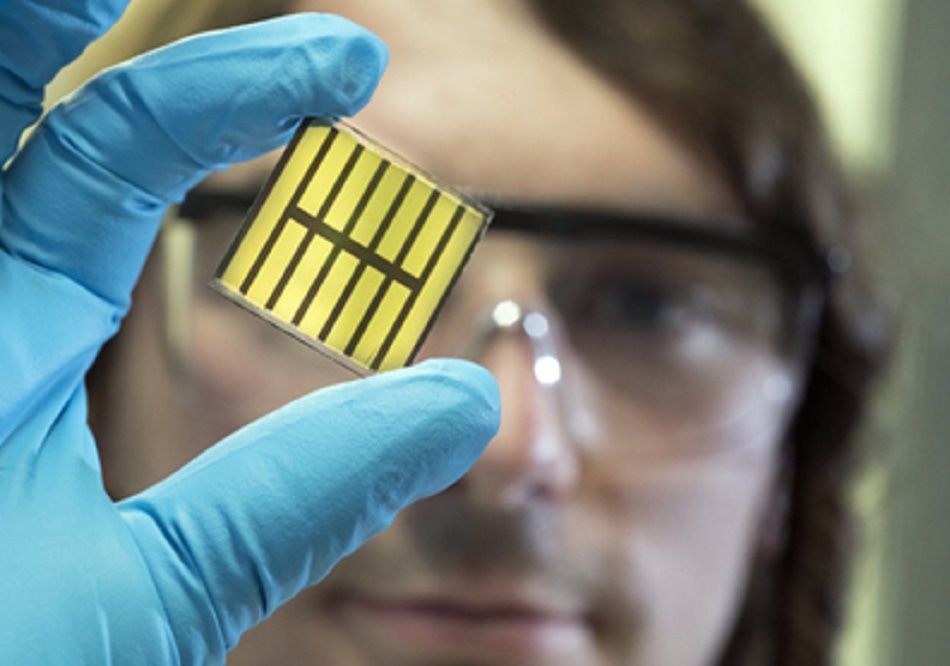
Image credit: Markus Breig, KIT
Solar modules today are limited in their current capabilities and the capacity for increasing efficiency can only be engineered to a limited extent, say researchers at the Karlsruhe Institute of Technology, Germany.
The Capitano project at Karlsruhe is exploring the benefits of combining perovskite with CIGS to enhance photovoltaic efficiency. The project and team, which commenced in July 2019, is led by Professor Michael Powalla and Ulrich Paetzold. Collaborating with the Karlsruhe team on the research is the Center for Solar Energy & Hydrogen Research Baden-Württemberg (ZSW) which acts as coordinator, KIT and the company NICE Solar Energy in Schwäbisch Hall.
The Karlsruhe team believe their current progress has significant implications for solar technology stating, "significantly more potential is offered by the use of two light-active layers in tandem solar modules. This promising technology could be the future of photovoltaics."
The technique involves combining thin-film solar modules – based on perovskite semiconductors – with semiconductors made of indium, gallium, copper, and selenium (CIGS). The resulting combination allows for efficient tandem solar cells with an enhanced efficiency potential of over 30% with all the advantages of thin-film technology.
Consisting of two different types of solar modules stacked on top of each other, tandem solar modules make better use of the spectrum of sunlight than the respective single solar cell. Thus, the resulting factor is that multiple solar modules will have greater efficiency. It is theoretically possible and believed that the new capabilities and efficiencies are way beyond the 30% demonstrated by simple silicon solar cells - their theoretical conversion limit is only 29.3% due to physical material properties.
Several variants of tandem modules are now available. Currently, in CIGS perovskite development, a perovskite solar cell transforms the light into electricity via the visible part of the solar spectrum. The underlying CIGS solar cell subsequently absorbs the light in the near-infrared spectrum, which then penetrates the perovskite solar cell. Each of these solar cells utilizes thin-film technologies that can easily be produced onto square-meter substrates. The exciting news is that this could help reduce costs while simultaneously achieving high efficiency, says the KIT team.
I expect great progress in the further development of this expertise, from the basics to the mass production of the project's promising technology.
Prof. Powalla, a Member of the Executive Board and Head of Photovoltaics at ZSW
Paetzold, the junior research group leader at KIT, added, "We are developing the next generation of highly efficient thin-film tandem solar modules, which have an efficiency of more than 30%. Promising fields of application are, for example, highly efficient solar modules for building-integrated photovoltaic solutions.”
The Capitano project is expected to run for a further three years as the German Federal Ministry for Economic Affairs and Energy is supporting it with a total of around €5.2 million, of which €2.1 million will go to KIT. The stated aim of the project is "to develop cells with stable higher efficiencies, which can be interconnected to form efficient tandem solar modules. The industrial partner NICE is to evaluate production on an industrial scale and to evaluate the costs."
Throughout the project each of the collaborators will have fixed goals, responsibilities, and purposes to manage and maintain. ZSW is responsible for developing new CIGS modules with optimized surface and adapted absorption spectrum (bandgap). Furthermore, they will be researching semi-transparent perovskite solar cells and modules with high efficiency and transparency.
The perovskite coating will then be tested with industry-relevant techniques such as slot casting. Vital sub-aspects include the optimized intermediate layers and adapted transparent contact layers. The results will be implemented in the fulfillment of series-connected tandem solar cells and modules. Furthermore, the environmental compatibility and impact of the manufacturing process will also be continually evaluated.
The role of KIT is to develop new materials and processes as well as submitting prototypes for the production of semi-transparent perovskite solar cells and solar modules with an adapted absorption spectrum (band gap), as well as being high in energy efficiency and high transparency. Particular interest is fostered in the scalable production methods such as slot casting or deposition from the gas phase in vacuum. Additionally, the scientists are developing a lighting management concept for improved luminous efficacy, this is due to the complex architecture of the tandem solar cells.
For the production of the tandem solar modules, NICE Solar Energy will provide the other partners with CIGS small solar modules from its CIGS innovation line. Cost comparison exercises with single-junction CIGS solar modules will be monitored with an annual production capacity of 300 megawatts assumed; this would be a production quantity on an industrial scale.
So, if the project meets expectation and yields the successful results expected the potential for these innovative solar cells to be scaled to industry is a prospect only three years away. This is welcome news in the world of renewable energy solutions, particularly for solar power which has previously faced criticism for being too expensive and not very energy efficient.
Disclaimer: The views expressed here are those of the author expressed in their private capacity and do not necessarily represent the views of AZoM.com Limited T/A AZoNetwork the owner and operator of this website. This disclaimer forms part of the Terms and conditions of use of this website.